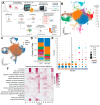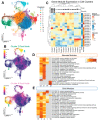Single-Cell RNA Sequencing Reveals Distinct Cardiac-Derived Stromal Cell Subpopulations
- PMID: 36354773
- PMCID: PMC9693599
- DOI: 10.3390/jcdd9110374
Single-Cell RNA Sequencing Reveals Distinct Cardiac-Derived Stromal Cell Subpopulations
Abstract
Human cardiac-derived c-kit+ stromal cells (CSCs) have demonstrated efficacy in preclinical trials for the treatment of heart failure and myocardial dysfunction. Unfortunately, large variability in patient outcomes and cell populations remains a problem. Previous research has demonstrated that the reparative capacity of CSCs may be linked to the age of the cells: CSCs derived from neonate patients increase cardiac function and reduce fibrosis. However, age-dependent differences between CSC populations have primarily been explored with bulk sequencing methods. In this work, we hypothesized that differences in CSC populations and subsequent cell therapy outcomes may arise from differing cell subtypes within donor CSC samples. We performed single-cell RNA sequencing on four neonatal CSC (nCSC) and five child CSC (cCSC) samples. Subcluster analysis revealed cCSC-enriched clusters upregulated in several fibrosis- and immune response-related genes. Module-based analysis identified upregulation of chemotaxis and ribosomal activity-related genes in nCSCs and upregulation of immune response and fiber synthesis genes in cCSCs. Further, we identified versican and integrin alpha 2 as potential markers for a fibrotic cell subtype. By investigating differences in patient-derived CSC populations at the single-cell level, this research aims to identify and characterize CSC subtypes to better optimize CSC-based therapy and improve patient outcomes.
Keywords: c-kit+ cardiac stromal cells; heart failure; single cell RNA sequencing.
Conflict of interest statement
The authors declare no conflict of interest.
Figures



Similar articles
-
Estradiol treatment promotes cardiac stem cell (CSC)-derived growth factors, thus improving CSC-mediated cardioprotection after acute ischemia/reperfusion.Surgery. 2014 Aug;156(2):243-52. doi: 10.1016/j.surg.2014.04.002. Epub 2014 Jun 21. Surgery. 2014. PMID: 24957669
-
C-Kit Positive Cardiac Stem Cells and Bone Marrow-Derived Mesenchymal Stem Cells Synergistically Enhance Angiogenesis and Improve Cardiac Function After Myocardial Infarction in a Paracrine Manner.J Card Fail. 2017 May;23(5):403-415. doi: 10.1016/j.cardfail.2017.03.002. Epub 2017 Mar 8. J Card Fail. 2017. PMID: 28284757
-
VEGF-A promotes cardiac stem cell engraftment and myocardial repair in the infarcted heart.Int J Cardiol. 2015 Mar 15;183:221-31. doi: 10.1016/j.ijcard.2015.01.050. Epub 2015 Jan 27. Int J Cardiol. 2015. PMID: 25679991
-
Cancer stem cells (CSCs), cervical CSCs and targeted therapies.Oncotarget. 2017 May 23;8(21):35351-35367. doi: 10.18632/oncotarget.10169. Oncotarget. 2017. PMID: 27343550 Free PMC article. Review.
-
Endogenous cardiac stem cells.Prog Cardiovasc Dis. 2007 Jul-Aug;50(1):31-48. doi: 10.1016/j.pcad.2007.03.005. Prog Cardiovasc Dis. 2007. PMID: 17631436 Review.
References
-
- Agarwal U., Smith A.W., French K.M., Boopathy A.V., George A., Trac D., Brown M.E., Shen M., Jiang R., Fernandez J.D., et al. Age-Dependent Effect of Pediatric Cardiac Progenitor Cells after Juvenile Heart Failure. Stem Cells Transl. Med. 2016;5:883–892. doi: 10.5966/sctm.2015-0241. - DOI - PMC - PubMed
-
- Sharma S., Mishra R., Bigham G.E., Wehman B., Khan M.M., Xu H., Saha P., Goo Y.A., Datla S.R., Chen L., et al. A Deep Proteome Analysis Identifies the Complete Secretome as the Functional Unit of Human Cardiac Progenitor Cells. Circ. Res. 2017;120:816–834. doi: 10.1161/CIRCRESAHA.116.309782. - DOI - PMC - PubMed
Grants and funding
LinkOut - more resources
Full Text Sources
Molecular Biology Databases

